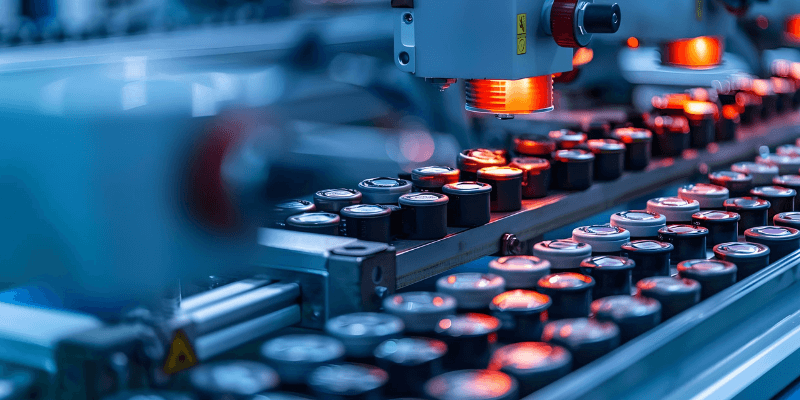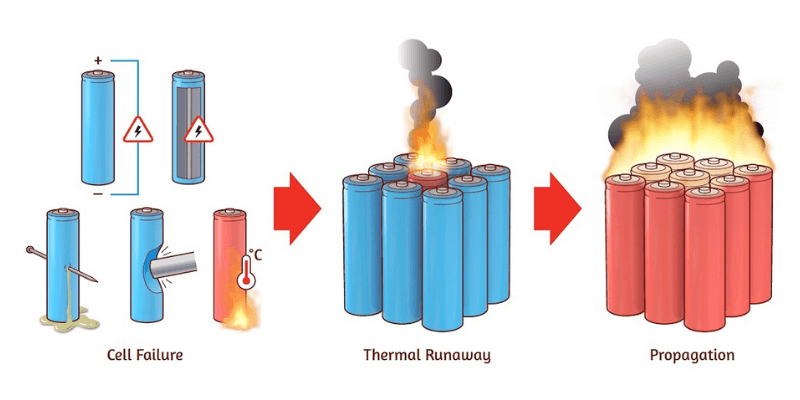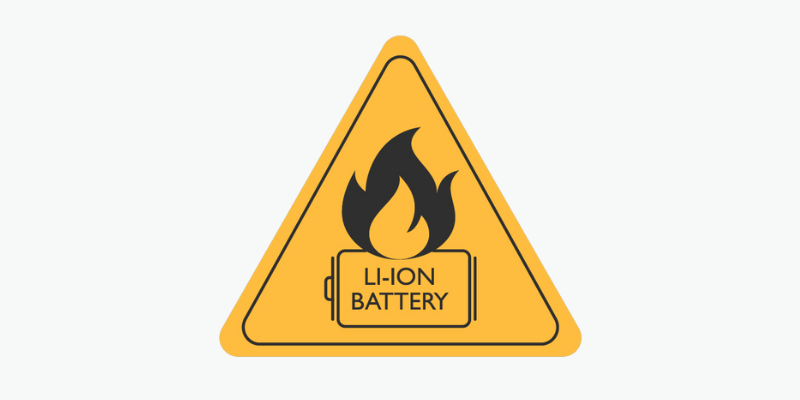La seguridad de baterías a base de litio ha estado bajo un intenso escrutinio, dibujando paralelos a los riesgos históricos de almacenamiento de energía como las explosiones de la máquina de vapor y las controversias de gasolina tempranas. Si bien la tecnología de iones de litio es generalmente segura, las fallas ocasionales, como el retiro de Sony 2006 de seis millones de paquetes, destacan los riesgos potenciales.
Los fabricantes de baterías tienen como objetivo reducir las partículas metálicas que pueden desencadenar cortocircuitos, a pesar de los desafíos para mantener la limpieza absoluta en las salas limpias de la batería. Las células con separadores ultra delgados (24 µM o menos) son más propensas a las impurezas que los diseños más antiguos. Como pueden encender, los nuevos estándares de seguridad de UL han evolucionado, ya que ya no requieren pruebas de penetración para la aceptación de baterías de litio.

Para garantizar la seguridad antes del lanzamiento, los fabricantes someten muestras de baterías a pruebas rigurosas, que requieren un millón de muestras sin fallas durante un año antes de aprobar aplicaciones críticas como dispositivos médicos.
A medida que la tecnología actual de iones de litio se acerca a sus límites de capacidad de energía, los fabricantes priorizan las mejoras de seguridad y longevidad sobre la capacidad. Los desafíos persisten con los cortocircuitos internos que pueden dominar las medidas de protección externa, como lo demuestra el retiro de 2006, que cumplió con los requisitos de seguridad de UL pero aún fallaron durante el uso normal.
Las fallas de la batería se dividen en dos categorías: fallas de diseño predecibles y eventos aleatorios sin problemas de diseño claros. Un corto menor puede causar una mayor descarga con una acumulación de calor mínima. Sin embargo, una acumulación de partículas metálicas puede conducir a un flujo de corriente significativo y un calentamiento excesivo, lo que puede causar potencialmente fuga térmica, a menudo descrito como “Aventando con llama.”
Además, los separadores desiguales aumentan la resistencia y generan puntos de calor locales que debilitan la integridad del separador. Mayoría principales fabricantes de iones de litio rayos X cada celda durante el control de calidad para detectar anomalías como pestañas dobladas o rollos de gelatina triturados – Contribuyendo a los estándares de seguridad de la batería de hoy que generalmente se mantienen solo por marcas reconocidas.

Avance de la seguridad de la batería de iones de litio: consideraciones clave
Las baterías de iones de litio de calidad son inherentemente seguras cuando se usan correctamente. Sin embargo, se han informado numerosos incidentes de calor y fuego en productos de consumo con baterías no certificadas, como los hoverboards. Estos problemas se han resuelto en gran medida con las baterías certificadas de iones de litio en modelos recientes.
El uso indebido, como la exposición a condiciones extremas o sobrecarga, puede conducir a fallas en todos los tipos de baterías, enfatizando la necesidad de prácticas de manejo adecuadas. Las células de iones de litio requieren un manejo cuidadoso para prevenir la inestabilidad, incluida la evitación de descargas profundas y la exposición prolongada de bajo voltaje. El calor y la sobrecarga son estresores principales para las baterías de iones de litio, lo que requiere prácticas de almacenamiento cautelosas como carga parcial y protección contra la luz solar directa. Los fabricantes tienen la responsabilidad de las fallas de la batería, subrayando su compromiso con los estándares de seguridad a pesar de los incidentes raros en el uso diario del dispositivo.
A pesar de más de mil millones de dispositivos móviles en uso diariamente, los accidentes siguen siendo raros – Menos de una falla por millón para las células de iones de litio de calidad en comparación con una probabilidad de 1 en 13,000 de ser golpeado por un rayo durante toda la vida.
Las baterías industriales utilizadas en herramientas eléctricas suelen ser más resistentes que los modelos de consumo, pero se centran en la entrega de energía en lugar de los largos tiempos de ejecución. Las células eléctricas son más seguras si se abusan en comparación con las células energéticas.
En los últimos años, las preocupaciones han destacado los riesgos asociados con las células de iones de litio de marca desconocida (18650) que a menudo se usan para vapear; Estos pueden carecer de la garantía de calidad que se encuentra en las marcas de buena reputación. Los incendios de baterías defectuosas de cigarrillos electrónicos han llevado a incidentes peligrosos, como un aterrizaje de emergencia de un vuelo de WestJet debido a un incendio a bordo causado por el transporte ilegal de la batería.
Con respecto a los vehículos eléctricos (EV), las estadísticas muestran que producen menos incendios por mil millones de kilómetros conducidos en comparación con los vehículos de motor de combustión interna (ICE): aproximadamente dos incendios por mil millones de kilómetros para Tesla versus alrededor de 90 para vehículos de hielo hoy, después de más de 400,000 autos de hielo se incendiaron durante los 80.

Qué hacer si una batería se sobrecalienta o se incendia
Durante un incidente de sobrecalentamiento de la batería de iones de litio, la acción rápida es vital. Si la batería silbosa o se abulta, mueva el dispositivo a una superficie no inflamable y considere reubicarla al aire libre. Simplemente desconectar la batería puede no ser suficiente para evitar más problemas.
Para pequeños incendios de iones de litio, use espuma, CO2, productos químicos secos, polvo de grafito, polvo de cobre o extintores de soda. En las cabañas de avión, las azafatas pueden usar agua o refrescos para manejar incendios de iones de litio debido al bajo contenido de litio en las baterías.
Las áreas de carga están equipadas con sistemas de supresión de incendios, como Halon, para gestionar los incendios de iones de litio junto con otros materiales inflamables. Los nuevos métodos de extinción como la dispersión acuosa de la vermiculita (AVD) y ExtOver® proporcionan formas innovadoras de sofocar las baterías ardientes; La arena en los contenedores de inicio de fuego también puede controlar efectivamente las quemaduras.
En el caso de los incendios de EV, que pueden ser más intensos que los que involucran vehículos de motor de combustión interna, se requieren métodos específicos de extinción de incendios. Los extintores de clase D se recomiendan para los incendios de baterías de litio-metal debido a su reactividad con el agua.
A medida que aumentan los números EV, la necesidad de evolucionar técnicas de extinción de incendios, como la incorporación de divisores entre las células para evitar las reacciones en cadena durante el fugitivo térmico, se vuelve esencial.

Pautas efectivas para manejar el incendio de la batería de iones de litio
- En el caso de una batería de iones de litio que fallan, marcada por el sissing, el abultamiento y la fuga de electrolitos, la acción inmediata es crucial para evitar riesgos potenciales.
- Se recomienda rociar un fuego de iones de litio con agua o usar un extintor estándar de incendios para mitigar el riesgo de encendido de materiales combustibles cercanos.
- Cuando se trata de incendios de litio-metal, es esencial utilizar un extintor de incendios de clase D debido a la naturaleza reactiva del litio con agua.
- En ausencia de un extintor de clase D, el agua se puede usar como alternativa para evitar que el fuego se propague de manera efectiva.
- Para resultados óptimos en la extinción de un fuego de iones de litio, se pueden emplear varios agentes de extinción como espuma, CO2, químico seco ABC, polvo de grafito, polvo de cobre o refrescos, similar a los escenarios de fuego combustibles estándar.
- En los casos en que no se puede extinguir una batería de iones de litio en llamas, permitir que el paquete se queme de manera controlada es un enfoque viable. Es importante monitorear la propagación de la célula, ya que cada célula puede quemarse a diferentes tasas cuando se expone al calor, y eliminar de manera segura los paquetes aparentemente quemados colocándolos al aire libre durante un período de tiempo para minimizar los riesgos potenciales.

